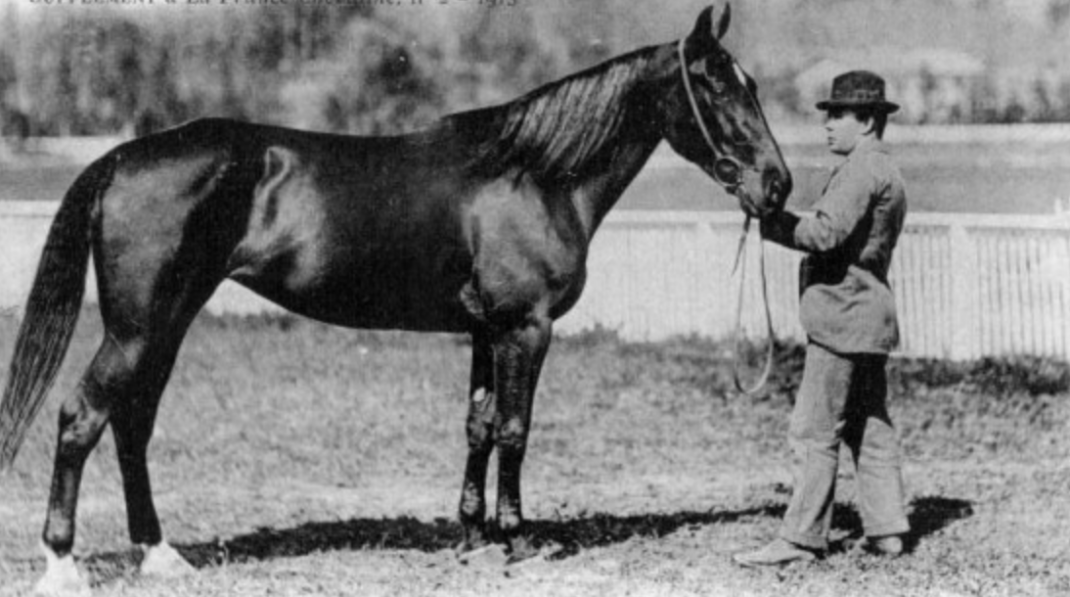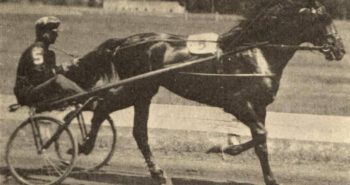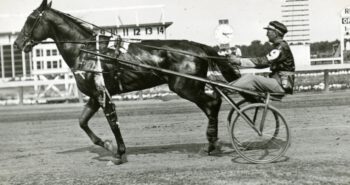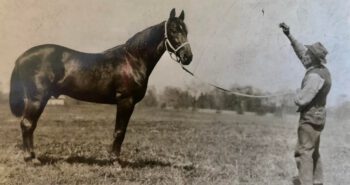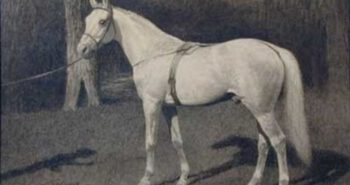She had six foals, all daughters, but died way too early at 12. Despite this, Mamie has left an exceptional legacy and is counted as one of the most important broodmares in trotting history.
The story of Mamie and the Leyburn-trotters originates in Midway, Kentucky, so named for its location midway between Lexington and Frankfort. During the Civil War, the Kentucky legislature declared the state to be neutral, but quite a few Kentuckians still joined the army on either side. One of those was Philemon Price Parrish, born in Midway in 1839, who joined the Confederate army. Records show that he served as a private in the 5th Regiment, Kentucky Cavalry of the Confederate army throughout the civil war.
Afterwards he returned home to Midway. In 1870 he married Margaret Emma McGoffin. By that time he had established himself as a farmer and already laid the foundation for future success in the harness world. According to an 1901 article published in The Inter Ocean, “Shortly after the war Mr Parrish bought at the sale of a Mrs Martin in Scott Country the broodmare Kit, by American Boy. He bred her to Star Almont and got the founder of the Leyburn family in Mamie. W.B. Brashfield said she was the fastest 3-year-old he ever drove, but she developed a quarter crack and was turned out, thus entering the broodmare ranks.”
Mamie was born in 1880. Bred to Crittenden at 3 because of the issues above, she gave birth to Criterion in 1884. The filly foal was one of six foals the Midway matron delivered – and curiously enough, all were fillies. The black Criterion was a decent racehorse won took a 2:29 3/4 (1.33,1) record on Aug 29, 1889. The mare was supposedly a lot better than her record, but had a temper and was often not on her best behavior. The same day Criterion’s chestnut three-year-old little sister Catherine Leyburn, by Onward, won in 2:27 1/2 (1.31,7). This accomplished an unprecedented feat of putting a mare’s two first foals in the 2:30 list by the time she was nine. It would get even more impressive as all of Mamie’s daughters started and won. The 1887 foal, Rose Leyburn, by Onward, a one year younger full sister to Catherine, became an accomplished pacer with a p2:15 1/4 (1.24,1) record. Like her older full sister, she also won at three. That year, in 1890, Mamie had her fourth foal. That was Helen Leyburn, also by Onward. 1891 saw the birth of the fourth daughter by Onward, Alice Leyburn, before she had Scourine, by Wilton, in 1892.
However, on Nov 11, 1892, the Lexington Herald-Leader reported that the Midway matron was dead. “Mamie, by Star Almont; dam Kit by Long’s Hambletonian, is dead at Midway, where she is owned by P.P. Parrish. Mamie was a great mare, all of her produced that were ever trained, having entered the list.” The article does not list a cause of death. An Feb 24, 1895 article in the same newspaper had a statement from Thomas Settle, former trainer of Catherine Leyburn, who stated that “Mamie, by Star Almost, dam Kit, by Long’s American Boy, was the dam of six daughters, all now in the 2:30 list. She died in October 1892, at the age of twelve years, the result of slipping a foal.”
In 1894, Mamie’s last foal, the two-year-old Scourine, showed exceptional talent when she trotted 2:23 1/2 (1.29,2) in early July. In just further underlined Mamie as an exceptional producer of early speed. The same year Anderson Bell, a son of Bell Boy and Mamie’s first-born Criterion, paced in 2:12 (1.22,0) at the Fort Wayne track. Just a few days later the horse, also bred by Parrish, dropped dead in training.
The trotting machine
Rose Leyburn gave birth to two important foals. The son Wilburn M, by Wilton, trotted 2:10 (1.20,8) in Austria and became a very important and influential stallion in Europe. In Austria he sired the superstar Willy 2:05 (1.17,7) before being sold off to Russia. The colt who, for whatever reason, was referred to as “Wilburn M” in Europe, turned out to be a good stallion in Russia. Among his many good get he most notably sired Centurion (Tsenturion), winner of the 1910 Russian Derby. However, it’s Rose’s daughter Margaret who was key to Mamie’s lasting legacy. Margaret Leyburn was named after both Parrish’s wife and daughter, and bred to Arion she produced Lady Leyburn in 1903. In 1908 Lady Leyburn gave birth to a daughter again named for the daughter of Mamie’s owner: Margaret Parrish. Good on the racetrack, she turned out to be a stellar broodmare. She was the dam of Arion Guy 1:59.3 and Margaret Castleton 1:59.1, and Valley Victory, Sugarcane Hanover, Fresh Yankee and the pacer Nihilators are among the many great horses going back to Rose Leyburn through Margaret Parrish.
On Mar 9, 1895, the New York Tribune reported that “it is believed by competent horseman that in Helen Leyburn, Mr. Bennett has a mare that would surely beat 2:09 1/2 (1.20,5) next season if she were to remain in this country to enjoy the advantage of the perfectly constructed and conditioned tracks. She came out practically green last season, as a four-year-old, and within a few weeks trained down to a record of 2:14 (1.23,3), defeating some of the fastest trotters on the turf. Her trainer of last year, Crit Davis, of Harrodsburg, KY, calls her “the trotting machine”, so pure and perfect is her action. The mare is not a handsome animal, having a large, coarse head, and carring a good deal of flesh, but she possessed remarkable bone and substance and is altogether a most serviceable-looking trotter. She is one of the best bred mares in existence, being by the noted sire Onward 2:25 1/4 (1.30,3), who was by George Wilkes, out of the dam of Director 2:17 (1.25,1), the sire of Directum. Helen Leyburn’s dam, Mamie, by Star Almont, is also the dam of Catherine Leyburn 2:16 1/4 (1.24,7), Scourine 2:23 1/2 (1.29,2) and Alice Leyburn 2:29 1/4 (1.32,8).”
However, Helen Leyburn was then already taken out of the country by Gordon Bennett. The Onward daughter took several good wins in the France, winning Prix de Joinville at Vincennes and Prix Clarence Mackay in Nice. In France she also set a record for 3200 meters (practically 2 miles), trotting in 1.32,8 (2:29.2) on Mar 19, 1895. Sold at the Tattersall Francais auction at April 24, 1897, Benoit-Koch purchased Helen Leyburn for 10,500 French francs. She raced for a little while before she was retired to stud. There she became a stellar broodmare and produced two exceptionally important horses in France. Her 1903-foal Dakota was a relatively good racehorse and even better at stud. The 1905-foal Fred Leyburn, though, was an exceptional trotter. He set a European record with 1.21,1 (2:10.2), won the Championship of Europe in 1911 and also the Grand Prix de Municipal three times in a row, from 1912 to 1914. This race was the pre-WWI edition of the Prix d’Amerique. Helen Leyburn unfortunately left no lasting impact, though, as she had no daughters.
Down to one horse
On Jan 16, 1907, Parrish sold off all his horses. Most of the mares stayed in Kentucky, though. In Lexington Herald-Leader it said “Edward and Joseph Madden, the two sons of JE Madden, the horseman, purchased eleven boodmares Wednesday from Mr. Parrish of the Leyburn Stud, near Midway. The Madden boys are going into the breeding business for themselves and the purchase of the group of Leyburn mares Wednesday was the inaugural transaction in their new enterprise. John Splan, who engineered the sale, says that although the amount of money involved in the transaction cannot be made public, it is in excess of any private sale held for some time.” It was then revealed that “Mr Splan said last night that the sum paid for the mares was the largest at a private sale since the time that Malcolm Forbes paid $125,000 for Arion.” Shortly after the sales Parrish changed his mind and decided to keep one horse. He then bought back Brook Leyburn, by Silent Brook and Belle Leyburn.
That was the start of the end for “the Leyburn stud.” But where did the name come from? After selling off his horses in February 1907 several newspapers reported that “It was while Mr Parrish had on his farm at Midway three mares, all daughters on Onward and Mamie, that he read the novel Robert Elsmere, and in that book are three fictitious characters, Rose Leyburn, Catherine Leyburn and Helen Leyburn. Mr Parrish was looking for names for these three mares and the idea struck him that it would not be out of place to call the three mares after the names in the book. He did, and they have done their share in making the family famous as a producer of splendid trotters. As Mamie was a consistent producer of filly foals, Mr. Parrish gave them any surname that came to his mind and used the name Leyburn. Catherine Leyburn is in the royal stud of France. Helen Leyburn is in the government stud of Germany and Rose Leyburn is a JE Madden’s Hamburg Place, in this country. Mr. Parrish has been breeding trotters for 42 years. He owned Kit, the dam of Mamie, which he bought the year after he left the Confederate army, and after 42 years breeding to establish a family he has but one member of that family of trotters left.”
| Year | Name | Sire | Career | Other info |
|---|---|---|---|---|
| 1884 | Criterion (f) | Crittenden | 2:29 3/4 (1.33,1) | |
| 1886 | Catherine Leyburn (f) | Onward | 2:14 (1.23,3) | Exported to France. |
| 1887 | Rose Leyburn (f) | Onward | p2:15 1/4 (1.24,1) | |
| 1890 | Helen Leyburn (f) | Onward | 2:14 (1.23,3) | Exported to France. |
| 1891 | Alice Leyburn (f) | Onward | 2:29 1/4 (1.32,8) | |
| 1892 | Scourine (f) | Wilton | 2,2:23 1/2, 2:18 1/2 (2,1.29,2, 1.26,1) |
Brook Leyburn, however, didn’t amount to much on the racetrack. In November 1915, Philemon Parrish died at his home in Midway. His legacy, and that of his spectacular broodmare, still lives on, though.
MAMIE
Brown mare born in Midway, KY in 1880. Died in Kentucky in 1892.
Star Almont – Kit (Long’s American Boy)
unstarted
Breeder: Philemon P Parrish
Owner: Philemon P Parrish
Trainer: Mike Bowerman
Driver: –
Groom: –

